|
| |
| |
| |
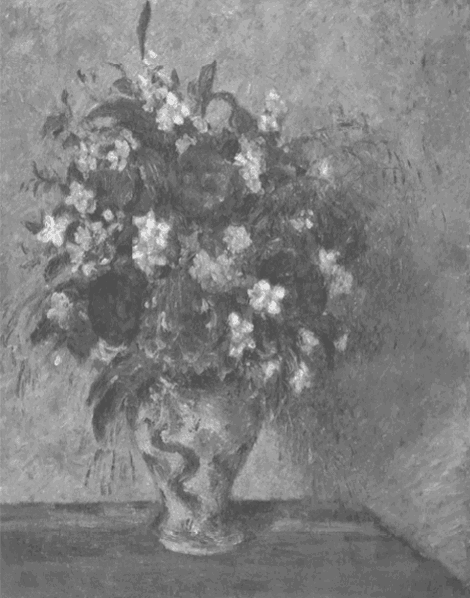
fig. 1
Camille Pissarro, Still life with peonies and mock orange, 1872-74 and 1876-77, Amsterdam, Van Gogh Museum, Sara Lee Corporation Millennium Gift
| |
| |
| |
Review
August 1999 -July 2000
Introduction
After the successful completion of the building programme and the reopening in June 1999, work at the Van Gogh Museum has returned to a more normal pace. Following the many hectic months of preparation, planning and work that went into the development of a new exhibition wing and the renovation of the existing building, the museum has at last been able to give its full attention to its core business: looking after the collection and serving the public.
In many respects this has been an excellent 12 months for the Van Gogh Museum. The rejuvenated museum has enjoyed a record attendance. At the time of writing, we have welcomed over 1.5 million visitors since the reopening. We have been able to offer these visitors improved service on all fronts, as well as a wider range of educational materials to enhance their enjoyment and understanding of the displays. The new building has continued to attract international attention, and it has been a delight to observe how the architecture has provided a stunning setting for a variety of exhibitions. The welcome support of the Vincent van Gogh Foundation has enabled us to make a spectacular acquisition of an entire collection of late 19th- and early 20th-century prints. And, less visible but equally important, the museum has continued to support an active programme of research into Van Gogh and 19th-century art.
| |
The collection
The bulk of the permanent collection on display at the Van Gogh Museum is on loan from the Vincent van Gogh Foundation. The museum works in partnership with the foundation not just to conserve the collection for the enjoyment of future generations but also to expand it through new additions. The Vincent van Gogh Foundation has helped with a great many acquisitions in our history, but this year it made its most impressive contribution to date with the purchase of a collection of over 800 prints, mainly by artists associated with the Nabis group. From its origins in the works assembled by Vincent and Theo van
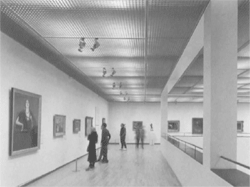
fig. 2
Third floor of the Rietveld building with Kees van Dongen's Blue dress, purchased in 1999 with the support of the Dutch Sponsor Lottery
Gogh, the collection has always represented works on paper, but this acquisition gives an important new core to the holdings of graphic art, and allows us to present some of the most exciting developments in printmaking in the later 19th century. The newly acquired pieces include the majority of the best Nabis prints made in Paris between 1890 and 1905, with superb works by Henri Toulouse-Lautrec, Pierre Bonnard, Edouard Vuillard, Maurice Denis and Félix Vallotton. Assembled over many years by a private collector, the prints are generally of the highest quality and in excellent condition. A selection of highlights from the collection was shown on the second floor of the Rietveld building this past summer, and a number of works are reproduced in this volume of the Van Gogh Museum Journal (see also colour plates pp. 114-19).
Another important acquisition, also published in this Journal, is the gift of Camille Pissarro's Still life with peonies and mock orange from the Sara Lee Corporation. In
| |
| |
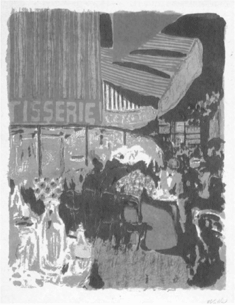
fig. 3
Edouard Vuillard, Paysages et intérieurs: la pâtisserie, 1899, Amsterdam, Van Gogh Museum (Vincent van Gogh Foundation)
an unprecedented and enlightened act of generosity, the company has given away the lion's share of its impressive art holdings to 40 different museums across the world, from Chicago to Singapore. The Van Gogh Museum is proud to have been selected as a beneficiary for part of this millennium gift, and we are delighted to add the first oil painting by Pissarro to the permanent collection (see also colour plate p. 120).
As well as displaying our collection here in Amsterdam, the Van Gogh Museum has lent generously to museums and exhibitions both in this country and abroad. Of particular note this year was the museum's major contribution to Van Gogh: face to face (on show at The Detroit Institute of Arts; The Museum of Fine Arts, Boston; and The Philadelphia Museum of Art), and to the Van Gogh exhibition organised by Ronald Pickvance for the Gianadda Foundation in Martigny in Switzerland.
Closer to home, in last year's Journal we reported on a series of exchanges with the Rijksmuseum and the Stedelijk Museum. This programme has continued, with Whistler's Portrait of Effie Deans arriving on loan from the Rijksmuseum. Another initiative - a long-term loan of a group of paintings by Van Gogh to enrich the displays at the Rijksmuseum Twenthe - had to be postponed when the museum was badly damaged in a horrendous explosion at a nearby fireworks depot in May of this year. We wish our colleagues in Enschede every success in their efforts to restore and reopen their building to the public.
| |
Research
Through our own research programmes and by acting as a forum for outside scholars and other institutions, the Van Gogh Museum has become a focal point for the research and study of Vincent van Gogh and his period. The museum is currently engaged in two long-term research projects: the production of a series of catalogues of our
| |
| |
holdings of Van Gogh, and a new edition of the artist's letters. The latter will result in a new scholarly edition of Van Gogh's complete correspondence, with revised texts, new English translations and annotations. Although the edition is not due for publication until 2004, the research continues to provide a steady stream of new insights into the content and dating of the letters, and their significance for the understanding of Van Gogh (see the article by Leo Jansen, Hans Luijten and Wouter van der Veen in this year's Van Gogh Museum Journal).
The Van Gogh collection will be catalogued in a series of eight volumes. Three of these have already been published: two volumes on the drawings (until 1885) and one on the early paintings. Work is now proceeding on the third volume of drawings (to be published in 2001) and the second volume of paintings (to be published in 2002), both devoted to the artist's period in Antwerp and Paris.
Original research in our museum is not an isolated activity with its own ends and means, but rather feeds into and supports virtually all our activities. In particular we are committed to using the results in order to engage not just the scholarly community, but our audience as a whole. The technical, archival and curatorial work carried out in conjunction with the exhibition of the collection of Dr Gachet (see below) is a good example of how such research can enhance a presentation for the public. The detailed investigation into the authenticity of a single painting, Van Gogh's Garden of St Paul's Hospital, was presented on the Internet and in a video shown in our auditorium. The researchers' detective work not only dispelled any lingering doubts about the genuineness of this picture, but also made for an engaging exposition on Van Gogh's working methods.
In 1996 a project was initiated to produce an inventory of all the French 19th-century paintings in Dutch public collections. This work, carried out by Aukje Vergeest, is now complete and the corpus, entitled The French collection, was published by Amsterdam University Press in November this year.
| |
Exhibitions
Over the past year the new wing has proved its worth as a practical and beautiful setting for temporary exhibitions. Shows can now take place without disrupting the permanent collection and with the luxury of a space that not only allows plenty of room for the public but also encourages experimentation with different approaches to installation. Diversity, variety and the surprise of the unfamiliar are essential ingredients in our effort to present the broadest possible range of subjects from the 19th century, and the versatile architecture of the wing is an excellent backdrop to this programme.
Our major exhibition for the reopening in 1999 was consecrated to Theo van Gogh (see the Van Gogh Museum Journal 1999) and was quickly followed by another important international touring presentation: Cézanne to Van Gogh: the collection of Doctor Gachet, organised in collaboration with The Metropolitan Museum of Art in New York and the Musée d'Orsay in Paris. The Gachet family's gift forms an important element in the French national holdings of impressionist and post-impressionist art. The eccentric and colourful Paul Gachet is probably best known as the friend and patron of several artists, including Cézanne, Pissarro, Guillaumin, Monet and Van Gogh. A homeopathic physician and enthusiastic amateur artist, he acquired seminal examples of his friends' work, which were later donated to the French state by his son. The show was the first occasion on which the Gachet donation had travelled abroad, and was enriched by other loans, including copies made by Gachet, his son and other amateurs in their circle. It has been alleged that certain works in the Gachet donation are not genuine, and this provocative display gave the public the chance to compare originals and copies and to examine the results of the art-historical and technical research. A comprehensive catalogue, edited by Anne Distel and Susan Stein, was published to accompany the exhibition.
The print room in the new wing was the venue for a show concerned with the artist Van Gogh once described as ‘Father Millet.’ Today, Jean-François Millet is perhaps best known for his monumental paintings of peasant life, but the emphasis here was on his superb and highly influential drawings, many of which were produced as works of art in their own right. Curated by Alexandra Murphy, the show originated at the Sterling and Francine Clark Art Institute in Williamstown and, after the Amsterdam venue, travelled to the Frick Art Museum & Historical Center in Pittsburgh.
The large and ambitious exhibition Prague 1900: poetry and ecstasy made full use of the new wing's architecture, combining furniture and decorative objects with paintings, drawings and graphic art in a lavish display. Following on from Glasgow and Vienna, this was the third
| |
| |
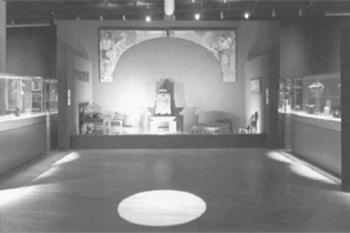
fig. 4
Prague 1900: poetry and ecstasy, Van Gogh Museum, 1999-2000 (photograph by Luuk Kramer)
in a series of shows at the Van Gogh Museum to explore the dynamic changes in an important artistic centre at the turn of the century. The show, developed by Edwin Becker, evoked the sensuous language of forms and the poetic symbolism characteristic of Art Nouveau in Prague. It was possible to trace links with artistic movements elsewhere in Europe - from impressionism to expressionism - yet at the same time to experience a rich local and national artistic tradition. The generous collaboration of The National Gallery and the Museum of Decorative Art in Prague allowed us to show examples of the highest quality from a period that deserves to be better known outside the Czech Republic. The accompanying catalogue gives an excellent overview of the period, with contributions from several specialists, including Petr Wittlich and Roman Prahl. After its Amsterdam showing the exhibition travelled to the Museum für Angewandte Kunst in Frankfurt am Main.
The exhibition Jugendstil in word and image was in many respects complementary to the Prague show, providing a view of another aspect of the creative surge that we associate with Art Nouveau in Europe. The close collaboration between artists and writers in the period around 1900 led to the creation of what can almost be described as a new art form in books and magazines. The exhibition included some 80 illustrations by artists such as Peter Behrens, Josef Hoffmann, Max Klinger and Koloman Moser, with texts by, among others, Stefan George, Hugo von Hofmannsthal and Rainer Maria Rilke. A thematic arrangement with suitably lyrical headings, such as ‘Dreams and fairy tales’ and ‘Enthralled by love,’ helped define the nature of this rich vein of material. Following its presentation in Amsterdam the show travelled to the Fondation Neumann, Gingins, Switzerland and the Museum Mathildenhöhe, Darmstadt.
In recent years the Van Gogh Museum has organised a number of exhibitions devoted to lesser-known artists of the 19th century. Often these were minor masters who were recognised in their own time, but whose work had since fallen out of fashion. This series was continued in the spring of 2000 with exhibitions on the Belgian artist Xavier Mellery and the French sculptor Jean-Baptiste Carpeaux.
Mellery's mysterious, intimate interiors attracted many admirers in the 19th century, including Vincent van Gogh, who, writing to his brother Theo about the Vingtistes in Brussels, stated in 1889: ‘I would like to exhibit with the Vingtistes in Brussels, but I feel inferior next to many Belgians who have great talent. That Mellery, for example, is a great artist. And he has been for many years’ [801/604]. In the 20th century, however, Mellery was almost entirely
| |
| |


fig. 5
Reflections: Japan and Japonism, Van Gogh Museum 2000 (photograph by Victor Levie)
forgotten, and this show, organised in cooperation with the Centre pour l'étude du XIXe siècle and shown subsequently at the Musée d'Ixelles in Brussels, was the first since 1937 dedicated to the artist. The exhibition was accompanied by a book by Vincent Vanhamme, the first monograph on the artist.
The Mellery exhibition included a number of his impressive designs for large-scale mural paintings. The artist had to live with the frustration that none of these were ever realised. Jean-Baptiste Carpeaux, by contrast, had no shortage of official commissions. This eclectic artist was the leading sculptor of the Second Empire in France, executing numerous portrait busts and several large sculptural groups in Paris, of which La danse for the Opéra and the Fountain of the four continents in the Jardin du Luxembourg are probably the most famous. This show, however, highlighted a more intimate aspect of Carpeaux's oeuvre, focusing instead on his paintings. This is a body of work Carpeaux made largely for his own satisfaction. His landscapes, portraits and history scenes are painted in a fluid, dramatic style, which emphasises their extraordinarily personal nature. The exhibition was organised with the Musée des Beaux-Arts in Valenciennes. A catalogue in French by Patrick Ramade, Laure de Margerie and Laurence des Cars was published by the Réunion des Musées Nationaux to accompany the show.
The year 2000 represents the 400th anniversary of the first contact between Japan and the Netherlands. As part of the wide-ranging celebrations in honour of this historical date, the Van Gogh Museum organised the show Reflections: Japan and Japonism. The exhibition provided an image of Japan as seen through the eyes of Vincent van Gogh and his contemporaries. Japanese objects and prints traded in Europe from about 1850 were shown alongside Japoniste objects inspired by oriental works from private collections, including the splendid Herman Dommisse Collection. On 23 May 2000 the museum was honoured to welcome their majesties the Emperor and Empress of Japan, who were in the Netherlands on a state visit. Their majesties toured the permanent collection and paid a visit to the new wing to admire the architecture of Kisho Kurokawa.
| |
| |
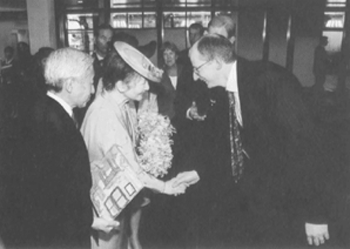
fig. 6
Director John Leighton greeting the Emperor and Empress of Japan on 23 May 2000 (photograph by René Gerritsen)
Perhaps our most innovative display of this season was the design evolved for the exhibition The spirit of Montmartre: cabarets, humour and the avant-garde 1875-1905. Organised in collaboration with the Jane Voorhees Zimmerli Art Museum at Rutgers, The State University of New Jersey, this show focused on the artistic and intellectual environment in Montmartre during the last decades of the 19th century. Using illustrated newspapers, prints, posters, a shadow theatre, drawings and a range of ephemera such as theatre programmes, the show evoked the heady, anarchistic world of Paris's earliest avant-garde. A novel installation - with empty wine glasses, tables strewn with newspapers and with background ‘noise’ - helped visitors make the imaginative leap to a lively Montmartre café. A specially published ‘Montmartre magazine’ in the form of a newspaper provided information and background about the period. The accompanying book was edited by Phillip Dennis Cate and Mary Shaw.
| |
Future project: Van Gogh - Gauguin exhibition
Together with the Art Institute of Chicago, the Van Gogh Museum is planning a major exhibition devoted to the collaboration of Van Gogh and Gauguin. The show will set the work of both artists in parallel and, although there is a natural focus on their brief spell of working together at Arles in 1888, will in effect entwine their entire careers, offering many insights into their mutual influence. The exhibition opens in Chicago in September 2001 and moves to Amsterdam in February 2002. The show at the Van Gogh Museum is made possible with the generous support of ABN-AMRO Bank.
| |
Education
The Van Gogh Museum pursues an active educational policy designed to meet the various needs of our diverse public. Information and explanatory material is provided in various forms, including wall texts, brochures and audio tours; much of this is made available in up to seven languages. A new video, produced in association with The National Gallery in London, is now shown continuously in our auditorium. Entitled Face to face with Vincent van Gogh, it is intended to provide a general introduction to the museum and to the artist's work.
Our new study area on the second floor consists of an open depot (where all the paintings by Van Gogh not in the main installation may be viewed), reading tables and a
| |
| |
bank of computers offering access to the museum's website. Since its launch in January 1999, the website has been updated and extended to include more works from the collection. The site is popular, attracting some 500 to 600 visitors a day. A new three-dimensional extension to the site went online in the autumn of 2000.
With the reopening of the museum in 1999 we launched our new programmes for schools. The education department now provides an extensive service designed to complement the courses followed by pupils at various stages in their education. The emphasis to date has been on secondary education, and a range of material - including a Van Gogh Museum newspaper, brochures on relevant themes and lessons guidelines for teachers - is now available. This material is much in demand, while the number of visits from schools has increased considerably.
| |
Friends of the Van Gogh Museum
From 1990 to 1998 the Van Gogh Museum enjoyed the support of a small but energetic organisation of Friends. Their many activities over the years included the running of the Information Desk, which was manned by a group of loyal volunteers. With the closure for renovation and the decision to make the Information Desk an integral part of its operations, the museum decided to disband the organisation in its then form. An appropriate construct for a supporting organisation in the future has yet to be fixed, but in the meantime the museum would like to express its gratitude to all those who contributed in different ways over the years through the Friends organisation. We are delighted that the Friends have left a parting gift, providing the funds to purchase the exquisite neo-impressionist watercolour on canvas by Louis Hayet (see p. 122) and also making a contribution towards our programme of improving the framing of the permanent collection.
| |
The Museum Mesdag
In 1996 the Museum Mesdag reopened after a major renovation and with the incorporation of the adjacent private dwelling of H.W. Mesdag (see the Van Gogh Museum Journal 1996). The publicity surrounding the reopening ensured a record attendance in 1997, but since then the visitor numbers have been disappointing. Occasional activities such as lectures have been well attended, but although it was always planned as a tranquil museum with an authentic atmosphere from the last century, it has not yet found the audience that it deserves locally nor - given the quality of its collections - has it become truly established as a national or international tourist attraction. Plans are being developed to reinvigorate the museum, for example with changing presentations and small exhibitions in combination with more activities aimed at serving and building up a loyal local audience. A full-time curator/manager will be appointed later this year. A new, fully illustrated guide to the museum was published in English and Dutch in 1999. The guide includes an introduction to the paintings by Fred Leeman, texts on the Japanese objects by Menno Fitski and on Colenbrander by Christien Smits.
| |
Attendance figures
From the reopening in June 1999 until December 1999, the Van Gogh Museum attracted 763,448 visitors. From 1 January to 30 September 2000 the museum has received 1,032.687 visitors. A total of 8,513 people visited the Museum Mesdag in 1999
John Leighton
Director
|
|